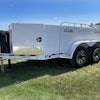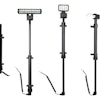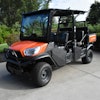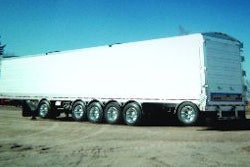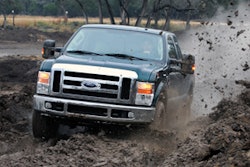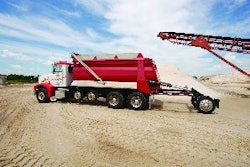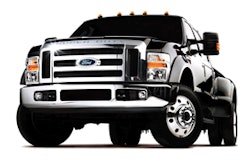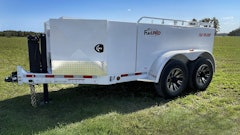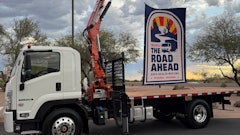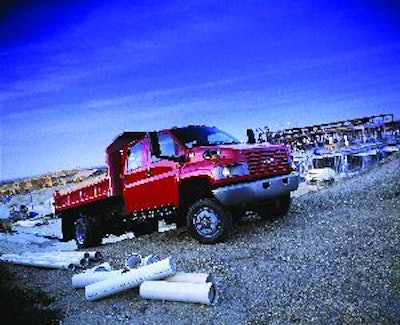
Traditionally, we have heard that users of vocational trucks are more concerned about performance than fuel economy. But with the volatile price of diesel fuel, anything you can do to reduce fuel consumption is worth a second look.
There are several variables you can control when it comes to fuel efficiency. According to Kelly Como, on-highway segment manager, Sterling Truck Corp., the three main areas of focus include vehicle specs, driver education and maintenance.
Spec it right
Engine size, gearing and weight are just a few factors that impact fuel consumption.
Engine size ranks among the most important factors. "A good match between the engine and the payload is significant," says Steve Matsil, global vehicle chief engineer, General Motors.
If the truck engine is too large for the application, you add unnecessary weight and upfront cost, plus you can burn more fuel while under-working the engine. Drivers are also more prone to use the excess horsepower, resulting in higher fuel consumption.
If the engine is undersized, it will be overworked, leading to increased engine wear and poor fuel economy. "If you are constantly in an underpower condition - meaning you are putting out the maximum horsepower of the engine to accelerate to cruising speed to move into traffic - you are always in a two-pedal position either off or on the throttle," says Matsil. "I suspect that you will not get the optimum fuel economy."
If you have adequate horsepower but misuse it by accelerating harder than you need to, he adds, you also lose fuel economy.
For best results, match the power curve of a particular engine to your application. You need to consider the gradeability and startability.
"The gear ratio is another significant point," says Matsil. "If you can get away with a numerically lower gear ratio, rear axle ratio - which means your accelerations will not be as brisk - that will help with fuel economy." The trade-offs would be startability and gradeability.
Weight is another issue. A light truck makes it possible to haul a larger payload. But remember that many trucks, such as dump trucks, spend half of their life travelling around empty.
In addition, consider aerodynamic efficiency if your trucks spend much time travelling down the road. "As you improve the coefficient of drag - the aerodynamic efficiency - you squeeze more miles out of the same gallon of fuel," says Matsil.
Tire care
Tire inflation is closely linked to fuel economy. "Don't over or under inflate," Matsil emphasizes. "Inflate to the manufacturer's recommended pressure."
The vast majority of tire pressures outside the normal range are below recommendations. This is because tires naturally lose pressure over time - air permeates through the rubber. "The air molecules escape between the bead of the tire and the mounting surface of the wheel," says Matsil.
As tires deflate, rolling resistance increases. "As you start to lose tire pressure, your sidewalls start to sag," Matsil explains. There is more rubber on the road. "You have more friction, so the rolling resistance increases. Consequently, the amount of energy required to move the vehicle down the road increases."
Como agrees, noting, "Tires that are under-inflated increase rolling resistance and make the engine work harder and burn more fuel. Tire pressure needs to be accurately gauged at least once a week."
However, when you measure tire pressure is critical. "When you inflate the tires, inflate them cold, meaning first thing before you start work in the morning or after the vehicle has been sitting for a while, because that is where you get the best, most accurate, readings," says Matsil. "The pressure changes 1 psi for every 10° F change in temperature."
The affects of proper tire inflation and wheel alignment on fuel economy can't be overstressed. "Tire pressure and axle alignment could account for 3% to 4%," says Como.
Another consideration is the use of radial vs. bias ply tires. "Radial ply tires should get you some incremental improvement vs. bias ply," says Matsil. That is because they have less rolling resistance.
Incremental gains
There are other maintenance items that can result in incremental gains in fuel economy. "Full fuel filters (run too long) can essentially derate engine power and force downshifts, making for inefficient operation," says Como.
In dusty construction environments, air filters should also be checked more frequently.
Reduce idle time
Truck idling is a common practice on jobsites. One reason is to run the air conditioning or heating systems in the cab to keep cabs comfortable in extreme ambient conditions.
Yet, as a truck idles, fuel is burned with no work being accomplished. "Idling consumes .5 gal./hour without air conditioning. Air conditioning increases fuel consumption by .4 gal./hour," says Como. "If you're stopped for more than five minutes, shut the engine off."
Unlike some older trucks, the electrical systems on modern trucks will not suffer any ill effects from frequent restarts. "Available options that we have today, such as heavy-
duty starter motors, will take multiple key-ons and key-offs during the day," says Matsil. "As a rule of thumb, if you do anywhere from six to 10 ignition starts a day where you crank the starter motor, it is pretty typical."
Most wear actually happens during cold starts. "The key is cold starts, especially in cold ambients," says Matsil. "Then you may get increased cylinder wear due to a minimum oil coating because of oil drain down. You may get some belt wear. You may drain the batteries down."
A warm engine already has a film of oil on bearing and cylinder wall surfaces. So if the engine is shut down, then restarted in five minutes, there is very little negative impact. "When the vehicle's fluids are at operating temperature, it takes a fraction of the energy to re-crank an engine," says Matsil.
Of course, there are instances where idling for short periods does make sense. If the truck has been pulling a very heavy load or traversing a steep grade, the engine may need to idle a few minutes to cool off key components.
"Let the temperature stabilize," Matsil advises. "If you shut the engine off right away, you will notice certain fluid temperatures will rise as heat transfers from the components. Without the machine moving the fluids around in the cooling system, engine and transmission, you will see the temperatures rise."
But if the truck isn't working near maximum capacity, this cool-down period isn't needed. "If I am driving mild grades where I am not really running near my operating max, I would shut it down," says Matsil.
Train operators
Drivers rank right up there with engine selection in their importance to fuel economy. Rapid acceleration, overspeeding the engine, late braking and excessive idling are all controlled by the driver. This is where training pays dividends.
"Driver factors can have the most significant affect on fuel economy," says Como. "Driver education is important. In fact, studies have shown up to a 35% difference in fuel savings from the best to the worst drivers."
One of the common errors is overspeeding the engine. "Keep rpms low - use the 'sweet spot' rpm, optimize shift points and use torque, not horsepower," says Como.
This is particularly true with manual transmissions. "There is no question if you have a manual transmission, you can shift it very aggressively," says Matsil "You can run the engine close to governed speed easier than with today's multi-speed Allison transmissions."
The current range of automatic transmissions compensate for poor driving habits. "They are optimized to give you the best of all worlds, even if you tromp on the accelerator," says Matsil. "They tend to shift well below the govern speed of the engine. For the inexperienced operator, today's automatic transmissions really provide a good balance for optimum fuel economy and minimum wear and tear on the vehicle."
But there are also benefits to a manual transmission. "It is relatively inexpensive compared to an automatic," says Matsil. "If the drivers are trained, then they don't destroy the clutches. There is very little maintenance and they are field serviceable. Many shops can work on a manual transmission. It is tougher for an automatic in terms of the nuances and what can go wrong with a rebuild."
Regardless of transmission type, frequent stops and starts should be avoided where possible. "Every stop and acceleration with 70,000 lbs. costs between .2 and .3 gal. of fuel," says Como.
Speed also has a large impact on fuel consumption. "If you are going to be able to cruise at 70 mph, a big chunk of your horsepower is just overcoming aerodynamic drag," says Matsil. "It is not a linear relationship. As you increase that speed, it literally becomes exponential the rate at which you need power to get through the air."
How the driver treats the throttle can also have a major impact on fuel economy. You want drivers to be smooth, not abrupt. Matsil suggests using the analogy of accelerating like you have an egg under the throttle. "The throttle movements should be very gentle so you are not going to crack that egg," he states. "That tends to have a positive influence on fuel economy."

